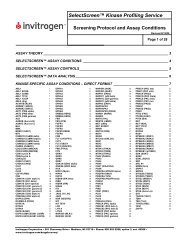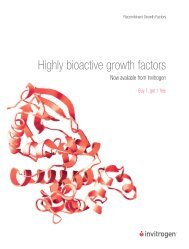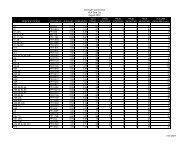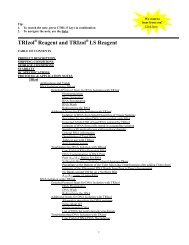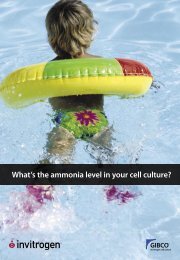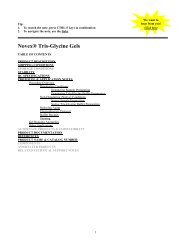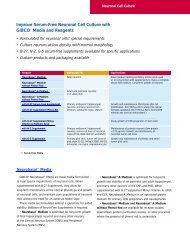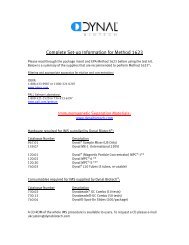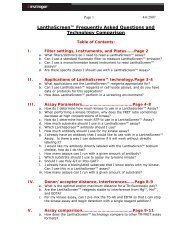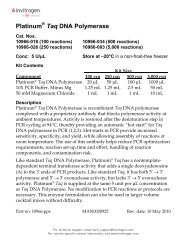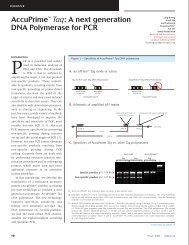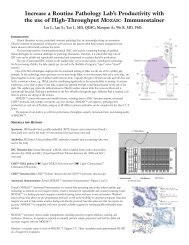Protocol - Invitrogen
Protocol - Invitrogen
Protocol - Invitrogen
Create successful ePaper yourself
Turn your PDF publications into a flip-book with our unique Google optimized e-Paper software.
<strong>Protocol</strong><br />
Page 1 of 3 Lit.# L0078 Rev. 06/00<br />
UDP-glycosyltransferase BACULOSOMES ® Transferase Activity Assay<br />
UGT1A1, UGT1A3, UGT1A6, UGT1A7, UGT1A10, UGT2B7<br />
Product # P2327, P2470, P2358, P2447, P2472, P2636<br />
1.0 PURPOSE/DISCUSSION<br />
The glucuronidation reactions catalyzed by human UDP-glycosyltransferase (UGT) enzymes play an important role in the metabolism of many<br />
drugs and other xenobiotics. UGT activity is defined by the transfer of glucoronic acid from UDP-glucuronic acid (UDPGA) to an aglycone<br />
substrate containing suitably reactive hydroxyl, sulfhydryl, aromatic amino and carboxylic acid moieties. UGTs are a group of integral<br />
membrane enzymes of the endoplasmic reticulum that have been divided into two families based on evolutionary divergence of their genes.<br />
UGTs of the 1A family play an important role in both the metabolism of dietary constituents, phenols, and therapeutic drugs, and also the<br />
glucuronidation of bilirubin and iodothyronines. UGTs of the 2B family are involved in the metabolism of bile acids, phenol derivatives,<br />
catechol-estrogens and steroids. Human UGT2B7 is one of the most important UGT isoforms. It glucuronidates opioids, hyodeoxycholic acid,<br />
catechol-estrogens, androsterone, and many non-steroidal anti-inflammatory drugs (NSAIDs) with high efficiency. Although it is widely<br />
recognized that the liver is the major site of glucuronidation, it is now clear that UGTs are also found in extra-hepatic tissues. To date, at least<br />
20 human UGTs have been cloned and sequenced. Several of them have been expressed in heterologous systems and have had their<br />
substrate specificity determined.<br />
2.0 SAFETY PRECAUTIONS<br />
Normal precautions exercised in handling laboratory reagents should be followed. Refer to the Material Safety Data Sheet(s) (MSDS) for any<br />
updated risk, hazard, or safety information. The reagents supplied are not considered hazardous according to 29 CFR 1910.1200. The<br />
chemical, physical, and toxicological properties of these products may not, as yet, have been thoroughly investigated. We recommend using<br />
gloves, lab coats, and eye protection when working with any chemical reagents.<br />
3.0 DESCRIPTION<br />
3.1 Reagents Supplied<br />
UDP-glycosyltransferase BACULOSOMES ® Reagents are microsomes prepared from Sf-9 insect cells that were infected with a recombinant<br />
baculovirus containing the cDNA for a specific human UGT. The substrates octyl gallate and α-naphthol can serve as general aglycone<br />
acceptors (probe substrates) for a variety of 1A family UGT enzymes using either TLC1 or organic extraction assays2 . Hyodeoxycholic acid may<br />
be used as a probe substrate for UGT2B7 organic extraction assays2 . In addition to the probe substrates, PanVera uses a variety of aglycones in<br />
order to demonstrate the substrate specificity for each recombinant UGT isoform. Control BACULOSOMES ® Reagents are prepared from the Sf-9<br />
insect cells infected with wild-type (non-recombinant) baculovirus. PanVera supplies a comprehensive panel of UGT products fro m both the 1A<br />
and 2B families including:<br />
1A family 2B family<br />
P2327 UGT1A1 BACULOSOMES ® Reagent 5 mg P2636 UGT2B7 BACULOSOMES ® Reagent 5 mg<br />
P2470 UGT1A3 BACULOSOMES ® Reagent 5 mg<br />
P2358 UGT1A6 BACULOSOMES ® Reagent 5 mg Control<br />
P2447 UGT1A7 BACULOSOMES ® Reagent 5 mg P2448 Sf-9 Control BACULOSOMES ® Reagent 5 mg<br />
P2472 UGT1A10 BACULOSOMES ® Reagent 5 mg<br />
3.2 Reagents Required but Not Supplied<br />
• 1 M Tris-HCl (pH 7.5)<br />
• 100 mM MgCl 2<br />
• 100 mM d-saccharic acid 1,4-lactone<br />
• Aglycone substrate stock solutions dissolved in methanol (10 mM octyl gallate, 100 mM α-naphthol)<br />
• 1 mg/mL phosphatidyl choline dissolved in water<br />
• 1 mM uridine 5′ diphosphoglucuronic acid (UDPGA)<br />
• [ 14 C]UDPGA, 320 Ci/mol (DuPont, NEC414)<br />
• 95% ethanol<br />
• 0.7 M glycine-HCl (pH 2.0) containing 1% (v/v) Triton ® X-100<br />
• Ready Safe Liquid scintillation cocktail (Beckman)<br />
545 Science Drive • Madison, WI 53711 USA • Ph. 800.791.1400 or 608.233.9450 • Fax. 608.233.3007 • http://www.panvera.com
<strong>Protocol</strong><br />
Page 2 of 3 Lit.# L0078 Rev. 06/00<br />
4.0 EXPERIMENTAL DESIGN<br />
The following is a suggested protocol for the measurement of UDP-glycosyltransferase activity. Two different methods are suggested for<br />
analyzing the transferase assay; both involve isolation of the [ 14 C]-labeled glucoronide reaction product. One method involves organic<br />
extraction and the other uses TLC to separate the glucuronidated metabolite from [ 14 C]UDPGA and the other reaction components. 1,2 The<br />
extraction method is much quicker to perform; however, when dealing with novel substrates, artifacts may be created by inefficient extraction of<br />
the glucuronidated substrate. An advantage to the TLC method is that the presence or absence of glucuronidated metabolites and [ 14 C]UDPGA<br />
can be visualized due to their different R f values.<br />
4.1 Procedure<br />
In general, the optimal rate of glucuronidation will vary depending on the recombinant UGT that is being tested. It is recommended that the<br />
investigator test the linearity of the assay with different protein and substrate concentrations. Information on UGT assay linearity with various<br />
probe substrates is available from PanVera. A guide to the conditions routinely used is shown below:<br />
Part # BACULOSOME Enzyme Substrate Substrate Concentration Protein Concentration Time<br />
P2327 UGT1A1 octyl gallate 100 μM final 0.4 mg/mL 10 min.<br />
P2470 UGT1A3 octyl gallate 200 μM final 0.4 mg/mL 15 min.<br />
P2358 UGT1A6 α-naphthol 100 μM final 0.4 mg/mL 20 min.<br />
P2447 UGT1A7 octyl gallate 100 μM final 0.2 mg/mL 20 min.<br />
P2472 UGT1A10 α-naphthol 1000 μM final 0.8 mg/mL 15 min.<br />
P2636 UGT2B7 hyodeoxycholic acid 50 μM final 0.4 mg/mL 15 min.<br />
We recommend using two negative controls for the assay:<br />
1. An incubation in the absence of aglycone acceptor (substrate)<br />
2. A control for endogenous insect cell glucuronidation activity using BACULOSOMES ® Reagent prepared from Sf-9 insect cells infected with<br />
a wild-type virus (Part # P2448).<br />
Incubations:<br />
For each 100 μL reaction make up two mixes:<br />
Buffer Mix<br />
Substrate Mix<br />
1 M Tris HCl, (pH 7.5) 10.0 μL cold UDPGA 8.0 μL<br />
100 mM MgCl2 10.0 μL<br />
100 mM saccharolactone10.0 μL<br />
ddH2O aglycone substrate<br />
7.8 μL<br />
1.0 μL<br />
phosphatidylcholine 10.0 μL<br />
[ 14C]UDPGA 3.2 μL<br />
In a microcentrifuge tube, combine 30 μL of Buffer Mix and 40 μL of BACULOSOMES ® Reagent. The concentration of BACULOSOMES ®<br />
Reagent used in each assay will vary depending on the UGT enzyme used. Pre-incubate for 2-3 minutes at 37°C and then start the reaction by<br />
adding 30 μL of Substrate Mix. Incubate at 37°C for the appropriate time and terminate the reaction by adding either 100 μL of 0.7 M glycine-<br />
HCl (pH 2.0) containing 1% (v/v) Triton ® X-100 (for extraction analysis), or 100 μL of pre-chilled 95% ethanol (for TLC analysis).<br />
545 Science Drive • Madison, WI 53711 USA • Ph. 800.791.1400 or 608.233.9450 • Fax. 608.233.3007 • http://www.panvera.com
4.2 Analysis<br />
<strong>Protocol</strong><br />
Page 3 of 3 Lit.# L0078 Rev. 06/00<br />
TLC Analysis: Vortex the quenched reaction and precipitate the protein by centrifugation in a microcentrifuge for 10 minutes at maximum<br />
speed. Transfer the supernatant to a fresh tube. Perform TLC analysis using 40 μL of supernatant as described previously. 2 Quantitate by<br />
scintillation counting of radioactive spots after autoradiography. Glucuronides can be identified by incubation of reaction products without<br />
saccharolactone, a glucuronidase inhibitor, and inclusion of β-glucuronidase.<br />
For organic extraction: Add 1 mL of water-saturated ethyl acetate and vortex the mixture for 5 minutes. Centrifuge the samples for<br />
5 minutes in a microcentrifuge at maximum speed. Precipitated protein will appear at the interphase. Transfer a 200- μL aliquot of the upper<br />
ethyl acetate phase to a scintillation vial, add scintillation cocktail, and count radioactivity. 1<br />
5.0 REFERENCES<br />
1. Matern, H., et al. (1994) Anal. Biochem. 219: 182-188.<br />
2. Bansal, S.K., et al. (1980) Anal. Biochem. 109: 321-329.<br />
6.0 BIBLIOGRAPHY<br />
1. Burchell, B., et al. (1995) Life Sciences 57: 1819-1831.<br />
2. Mackenzie, et al. (1997) Pharmacogenetics 7: 255-269.<br />
3. Tephly, T.R, et al. (1998) Adv. Pharmacol. 42: 343-346.<br />
BACULOSOMES is a registered trademark of the PanVera Corporation.<br />
Triton is a registered trademark of Union Carbide Chemicals and Plastics Co., Inc.<br />
Ready Safe is a trademark of Beckman.<br />
© 2000 PanVera Corporation. All rights reserved.<br />
545 Science Drive • Madison, WI 53711 USA • Ph. 800.791.1400 or 608.233.9450 • Fax. 608.233.3007 • http://www.panvera.com



